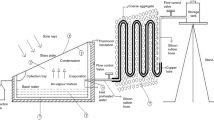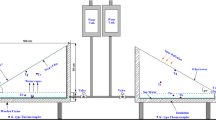Abstract
In this paper, the thermodynamic (energy and exergy) analysis and water analysis of a modified solar still augmented with copper tube heat exchanger in coarse aggregate have been carried out and compared with conventional still performance under the same climatic conditions. Basin water temperature, solar intensity, wind velocity, cumulative yield, water conductivity, total hardness, pH value and fluoride concentration are obtained from experimental results for saline, basin and distilled water. Energy efficiency, evaporation and convective heat transfer coefficient, exergy evaporation rate and exergy efficiency are determined from energy and exergy analysis. The results show that the modified still has an efficiency of 28% and 17% greater than the conventional still. The productivity of modified and conventional still is 6.23 kg m−2 and 2.41 kg m−2, respectively. The exergy efficiency depends on the time of the test day and reaches a maximum value of 5.5% and 1.1%, respectively, for the modified and conventional still. From the water analysis, it is observed that the maximum distilled water pH, water conductivity, hardness and fluoride content are 7.5, 0.8 × 10−4 S m−1 (0.8 µS cm−1), 0.5 × 10−3 kg m−1 (0.5 mg L−1) and 0.7 × 10−3 kg m−3 (0.7 mg L−1), respectively, with the still salinity removal efficiency of 99%. The results indicate that the modified still has higher energy and exergy efficiencies and better water quality with cumulative yield.














Similar content being viewed by others
Abbreviations
- h :
-
Heat transfer coefficient (W m−2 K−1)
- h fg :
-
Latent heat of evaporation (J kg−1)
- k :
-
Thermal conductivity (W m−1 K−1)
- L :
-
Length (m)
- U o :
-
Overall heat transfer coefficient (W m−2 K−1)
- m :
-
Yield per unit area (kg m−2)
- P :
-
Pressure (Pa)
- C p :
-
Specific heat at constant pressure (J kg−1 K−1)
- q :
-
Rate of heat transfer (W m−2)
- T :
-
Temperature (K)
- W :
-
Work (W)
- A :
-
Basin area of the solar still (m2)
- I(t)s :
-
Hourly incident solar radiation (W m−2)
- \({\dot{\text{E}}\text{x}}\) :
-
Exergy (W)
- \({\dot{\text{E}}\text{x}}_{\text{dest}}\) :
-
Exergy destructed in the solar still water (W)
- \({\dot{\text{E}}\text{x}}_{\text{sun}}\) :
-
Exergy input from the sun to solar still (W)
- \(\varepsilon_{\text{eff}}\) :
-
Effective emissivity
- \(\sigma\) :
-
Stefan–Boltzmann constant (5.67 × 10−8 W m−2 K−4)
- \(\eta_{\text{E}}\) :
-
Energy efficiency of the system (%)
- \(\eta_{\text{Ex}}\) :
-
Exergy efficiency of the system (%)
- \(\omega\) :
-
Uncertainty
- a:
-
Ambient air
- ba:
-
Basin
- c:
-
Convection
- ca:
-
Coarse aggregate
- eva:
-
Evaporation
- gl:
-
Glass
- i:
-
Input to the solar still
- ins:
-
Insulation
- out:
-
Output from the solar still
- hx:
-
Heat exchanger
- r:
-
Radiation
- S:
-
Sun
- sd:
-
Side of still
- ws:
-
Water surface
- w:
-
Water
- work:
-
Work rate of the solar still
References
Belyayev Y, Mohanraj M, Jayaraj S, Kaltayev A. Thermal performance simulation of a heat pump assisted solar desalination system for Kazakhstan climatic conditions. Heat Transf Eng. 2018;134:1–13.
Badran OO. Experimental study of the enhancement parameters on a single slope solar still productivity. Desalination. 2007;209:136–43.
A-Hayek I, Badran OO. The effect of using different designs of solar stills on water distillation. Desalination. 2004;169:121–7.
Naima MM, El Kawi MAA. Non-conventional solar stills Part 1. Non-conventional solar stills with charcoal particles as absorber medium. Desalination. 2002;153:55–64.
Aboabboud MM, Horvath L, Szepvolgyi J, Mink G, Radhika E, Kudish AI. The use OD thermal energy cycle unit in conjunction with a basin type solar still for enhanced productivity. Energy. 1997;22:83–91.
Abdallah S, Badran O, Abu-Khader MM. Performance evaluation of a modified design of a single slope solar still. Desalination. 2008;219:222–30.
Ayoub GM, Malaeb L. Economic feasibility of a solar still desalination system with enhanced productivity. Desalination. 2014;335:27–32.
El-Sebaii AA, Al-Ghamdi AA, Al-Hazmi FS, Faidah AS. Thermal performance of a single basin solar still with PCM as a storage medium. Appl Energy. 2009;86:1187–95.
Akash BA, Mohsen MS, Osta O, Elayan Y. Experimental evaluation of a single basin solar still using different absorbing materials. Renew Energy. 1998;14:307–10.
Panchal HN. Enhancement of distillate output of double basin solar still with vacuum tubes. J King Saud Univ Eng Sci. 2015;27:170–5.
Voropoulos K, Mathioulakis E, Belessiotis V. Experimental investigation of a solar still coupled with solar collectors. Desalination. 2001;138:28–31.
Murugavel KK, Chokalingam KK, Sridhar K. An experimental study on single basin double slope simulation solar still with thin layer of water in the basin. Desalination. 2008;220:687–93.
Velmurugan V, Srithar K. Solar stills integrated with a mini solar pond: analytical simulation and experimental validation. Desalination. 2007;216:232–41.
Nafey AS, Abdelkader M, Abdelmotalip A, Mabrouk AA. Solar still productivity enhancement. Energy Conversat Manag. 2001;42:1401–8.
Sahoo BB, Sahoo N, Mahanta P, Borbora L, Kalita P, Saha UK. Performance assessment of a solar still using blackened surface and thermocol insulation. Renew Energy. 2008;13:1703–8.
Sakthivel M, Shanmugasundaram S. Effect of energy storage medium (black granite gravel) on the performance of a solar still. Int J Energy Res. 2008;32:68–82.
Khalifa AJN, Ibrahim HA. Effect of inclination of the external reflector of simple solar still in winter: an experimental investigation for different cover angles. Desalination. 2010;264:129–33.
Sakthivel M, Shanmugasundaram S, Alwarsamy T. An experimental study on a regenerative solar still with energy storage medium: jute cloth. Desalination. 2010;264:24–31.
El-Sebaii AA, Ramadan MRI, Aboul-Enein S, El-Naggar M. Effect of fin configuration parameters on single basin solar still performance. Desalination. 2015;365:15–24.
Rajaseenivasan T, Murugavel KK, Elango T. Performance and exergy analysis of a double-basin solar still with different materials in basin. Desalination Water Treat. 2014;55:1786–94.
Dhivagar R, Sundararaj S. A review on methods of productivity improvement in solar desalination. Appl Mech Mater. 2018;877:414–29.
Kumar RK, Babu BG, Mohanraj M. Thermodynamic performance of forced convection solar air heater using pin-fin absorber plate packed with latent heat storage materials. J Therm Anal Calorim. 2016;126:1657.
Watmuff JH, Charters WWS, Proctor D. Solar and wind induced external coefficients for solar collectors. Rev Int. 1977;2:56.
Dunkle RV. Solar distillation-a roof type solar still and multi effect diffusion stills. Int Heat Transf Conf. 1961;1:895–902.
Baum VA, Bayaramov RB, Malevsky VM. Solar still in the deserts. In: Proceedings of international solar energy congress; 1976. p. 426.
Cooper PI. Maximum efficiency of single effect solar still. Sol Energy. 1973;15:205.
Tiwari GN, Gupta SP, Lawrence SN. Transient analysis of solar still in the presence of dye. Energy Conversat Manag. 1989;29:59–62.
Pandya B, Kumar V, Matawala V, Patel J. Thermal comparison and multi objective optimization od single stage aqua-ammonia absorption cooling system powered by different solar collectors. J Therm Anal Calorim. 2018;134:1–14.
Hepbasli A. A key review on exergetic analysis and assessment of renewable energy resources for a sustainable future. Renew Sustain Energy Rev. 2006;12:593–661.
Petela R. Exergy of undiluted thermal radiation. Sol Energy. 2003;74:469–88.
Kianifar A, Heris SZ, Mahian O. Exergy and economic analysis of a pyramid-shaped solar water purification system: active and passive cases. Energy. 2012;38:31–6.
Holman JP. Experimental methods for engineers. 8th ed. New York: McGraw Hill Publication; 2012. p. 62–5.
Sathyamurthy R, El-Agouz SA, Dharmaraj V. Experimental analysis of a portable solar still with evaporation and condensation chambers. Desalination. 2015;367:180–5.
Sathyamurthy R, Nagarajan PK, Edwin M, Madhu B, El-Agouz SA, Ahsan A, Mageshbabu D. Experimental investigations on conventional solar still with sand heat energy storage. Int J Heat Technol. 2016;34:597–603.
Sethi AK, Dwivedi VK. Exergy analysis of double slope active solar still under forced circulation mode. Desalination Water Treat. 2013;51:7394–400.
Pandey AK, Tyagi VV, Rahim NA, Kaushik SC, Tyagi SK. Thermal performance evaluation of direct flow solar water heating system using exergetic approach. J Therm Anal Calorim. 2015;121:1365.
Author information
Authors and Affiliations
Corresponding author
Rights and permissions
About this article
Cite this article
Dhivagar, R., Sundararaj, S. Thermodynamic and water analysis on augmentation of a solar still with copper tube heat exchanger in coarse aggregate. J Therm Anal Calorim 136, 89–99 (2019). https://doi.org/10.1007/s10973-018-7746-1
Received:
Accepted:
Published:
Issue Date:
DOI: https://doi.org/10.1007/s10973-018-7746-1




